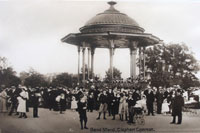
Picture courtesy of the Clapham Society
Clapham Common Bandstand

Picture courtesy of the Clapham Society
| The Clapham Common Bandstand: a short history The Clapham Common bandstand, built in 1890, is the oldest and largest surviving in Greater London, and one of the largest ever built in England. A Grade II listed building, it is a close replica of two bandstands, now destroyed, built by Francis Fowke in 1861 for the gardens of the Royal Horticultural Society in South Kensington. How it began – Clapham people asked for the bandstand The bandstand was built after local residents petitioned the London County Council in 1889 for “the great need our beautiful Common has for the erection of a Band Stand”. The previous summer, the Metropolitan Police Band had given regular concerts on Wednesday afternoons, attracting people from all over South London. Local shops closed on these afternoons to allow assistants to “enjoy rest and relaxation” by hearing the music. The LCC was encouraging music in parks, and readily agreed to the Clapham petition, allowing a budget of £600. (That would be getting on for £500,000 at today’s prices.) A few years previously, the Royal Horticultural Society had closed its gardens, and Fowke’s bandstands were sold to the LCC. They were re-erected in Southwark Park and Peckham Rye, but both lost in World War II. The contractor who was shifting them suggested that a copy might be made for Clapham Common. After a fruitless search for another secondhand bandstand (they even tried Paris), the LCC’s architect Thomas Blashill took up the idea, and designed a replica, with some modifications to stay within budget. It cost just £598. 100 years of use At first, concerts were just held on Wednesday afternoons. But in 1891, Sunday concerts began. There was some local objection, so the LCC made a condition that on Sundays there was to be no dance music! The area surrounding the bandstand was grass. Within a few years, there were complaints that it was invariably either muddy or dusty, so it was tar-paved, and also improved with belts of gravel and planting of shrubs. There was seating around it; at first, half of it was free, but from 1895 all charged for. The next twenty years were a great period for band concerts. Professional bands were coming in, as well as the traditional police and military bands. By 1905, the Head of LCC parks could write that Clapham was “one of the most frequented of all the commons... on Saturday afternoons especially it is teeming with London toilers.” All sorts of sports were allowed and “a horse ride and a bandstand make the attractions complete”. Use of the bandstand continued into the years after the Second World War. But by the 1960s and 70s, traditional cast iron bandstands were thought old fashioned, and performers preferred the “shell’’ or Hollywood Bowl type, on which they felt they were better seen. On Clapham Common, the LCC put up temporary stages, where there was boxing and ballet. Use of the bandstand did continue; Dire Straits and the Darts played there in an event organised by Charlie Gillett in 1977, and other bands played into the 1980s. But gradually use stopped. As the bandstand became derelict, in 1997 it was put on English Heritage’s “Buildings at Risk” Register. Its restoration launches a new stage in its history. Peter Jefferson Smith The Clapham Society June 2006 |